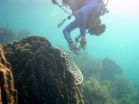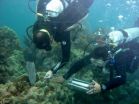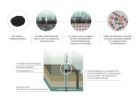(Press-News.org) Athens, Ga. – New research by University of Georgia ecologists sheds light on exactly what happens to coral during periods of excessively high water temperatures. Their study, published in the journal Limnology and Oceanography, documents a coral bleaching event in the Caribbean in minute detail and sheds light on how it changed a coral's community of algae—a change that could have long-term consequences for coral health, as bleaching is predicted to occur more frequently in the future.
Millions of people around the world depend on coral reefs and the services they provide. While coral reefs make up less than 0.1 percent of the sea floor, they serve as habitats for about 25 percent to 35 percent of all the oceans' fishes, roughly 500 million people worldwide rely on them as a source of protein and for coastal protection, and they are responsible for billions of dollars in tourism and fisheries revenue.
Corals, in turn, depend upon single-celled algae that inhabit them, providing most of their food and giving them their color. But many species of these algae are highly sensitive to temperature, and are unable to survive as ocean waters warm. The coral can expel these algae when the water temperature grows too high, a phenomenon known as coral bleaching.
Lead author Dustin Kemp, a postdoctoral associate in the UGA Odum School of Ecology, had the opportunity to study a bleaching event while conducting research at a reef off Puerto Morelos, Mexico. He and his colleagues had been working there since 2007, taking samples seasonally from six colonies of Orbicella faveolata, also known as mountainous star coral, and their associated symbiotic algae.
Orbicella is the major reef-building coral in most of the Caribbean, but although common, it has an unusual trait. While most species of coral associate with just one dominant type of symbiotic algae, O. faveolata is able to associate with up to four co-dominant types at once—some of which are heat-tolerant and some of which are not—making it a particularly interesting coral to study.
In October 2009, the researchers' sampling trip coincided with a period of unusually high temperatures, allowing them the rare opportunity to collect samples while a bleaching event was taking place.
"We were able to follow this coral at a very high precision and document how diverse assemblages of symbiotic algae are differently affected by the bleaching phenomenon," Kemp said. "This was probably the first study ever to look at it under natural conditions this closely."
Kemp took hundreds of samples approximately every 12 inches along established transects—a narrow section where measurements are taken—across all six coral colonies. He made sure to include samples from areas that appeared bleached as well as from those that still retained color. Because they had been collecting at the site for two years, and continued collecting after this event, the researchers were able to compare the communities of symbiotic algae before, during and after bleaching.
They observed that before the bleaching event, these particular corals contained three different types of algae, two of which were somewhat tolerant of the warm-water bleaching perturbation.
During the bleaching event, heat-sensitive algae were found to be much less prevalent while the heat-tolerant algae remained. Two months later, heat-tolerant algae had taken over the parts of the coral formerly occupied by the heat-sensitive algae.
"The corals didn't die after this bleaching event, they recovered—and that's good, that's important—but there could be potential tradeoffs associated with the shift to heat-tolerant algae," said Kemp, adding that, for example, some heat-tolerant algae may provide less food than those they might replace. "That question of tradeoffs is what we're working on now."
Kemp is currently conducting research at reefs in the Caribbean and Pacific, looking at how heat-tolerant algae affect corals in areas where corals have been documented to have stable, long-term associations with heat-tolerant algae.
"In the Caribbean, we've lost 80 percent of the corals just in my lifetime," Kemp said. "We know that increased ocean temperatures are one of the major threats to coral reefs worldwide. So understanding coral-algae dynamics, and how different algae can handle increased temperature, is important to see how the whole ecosystem will be affected by this environmental perturbation."
INFORMATION:
The study's coauthors are Xavier Hernandez-Pech and Roberto Iglesias-Prieto of the Universidad Nacional Autónoma de México, William K. Fitt of the UGA Odum School of Ecology and Gregory W. Schmidt of the UGA department of plant biology. The research was supported by the National Science Foundation and the World Bank. The paper is available online at http://aslo.org/lo/pdf/vol_59/issue_3/0788.pdf.
For more information about the Odum School of Ecology, see http://www.ecology.uga.edu.
UGA ecologists provide close-up of coral bleaching event
Study documents corals before, during and after October 2009 episode
2014-06-03
ELSE PRESS RELEASES FROM THIS DATE:
Moffitt researchers develop process to help personalize treatment for lung cancer patients
2014-06-03
TAMPA, Fla. (June 3, 2014) – Moffitt Cancer Center researchers, in collaboration with the Lung Cancer Mutation Consortium, have developed a process to analyze mutated genes in lung adenocarcinoma to help better select personalized treatment options for patients. Adenocarcinoma is the most common type of lung cancer in the United States with approximately 130,000 people diagnosed each year.
The study, published in the May 21 issue of The Journal of the American Medical Association, investigated 10 highly mutated and altered genes that contribute to cancer progression, ...
How long is too long to wait for groundbreaking aortic valve replacement surgery?
2014-06-03
Philadelphia, PA, June 3, 2014 – Severe aortic stenosis (AS) has a grave prognosis with 25-50% of patients dying within a year once symptoms develop. Transcatheter aortic valve replacement (TAVR) represents a paradigm shift in the therapeutic options for these patients. Because of cost and availability issues, there are often waiting times for this procedure. Investigators have found that even modest increases in wait times have a substantial impact on the effectiveness of TAVR in individuals who need it the most: otherwise inoperable patients and high-risk surgical candidates. ...
Stress hormone receptors localized in sweet taste cells
2014-06-03
PHILADELPHIA (June 3, 2014) – According to new research from the Monell Center, receptors for stress-activated hormones have been localized in oral taste cells responsible for detection of sweet, umami, and bitter. The findings suggest that these hormones, known as glucocorticoids, may act directly on taste receptor cells under conditions of stress to affect how these cells respond to sugars and certain other taste stimuli.
"Sweet taste may be particularly affected by stress," said lead author M. Rockwell Parker, PhD, a chemical ecologist at Monell. "Our results may provide ...
'Cool' factor separates e-cigarettes from nicotine inhalers
2014-06-03
Why are e-cigarettes so popular among Americans who want to quit smoking, even though so little is known about their safety or effectiveness? The answer lies in their marketing – they are simply "cooler" than nicotine inhalers. So says Michael Steinberg of the Rutgers Robert Wood Johnson Medical School in the USA, leader of a pilot study¹ about the perception and use of these nicotine delivery devices. The findings appear in the Journal of General Internal Medicine², published by Springer.
Nicotine inhalers work when nicotine vapor is breathed in and absorbed through ...
Night owls may be more sedentary, less motivated to exercise
2014-06-03
DARIEN, IL – A new study suggests that night owls are more sedentary and feel that they have a harder time maintaining an exercise schedule.
Results show that later sleep times were associated with more self-reported minutes sitting, and sleep timing remained a significant predictor of sedentary minutes after controlling for age and sleep duration. However, people who characterized themselves as night owls reported more sitting time and more perceived barriers to exercise, including not having enough time for exercise and being unable to stick to an exercise schedule ...
More than 10 percent of heart attack patients may have undiagnosed diabetes
2014-06-03
At least 10 percent of people who have a heart attack may have undiagnosed diabetes, according to new research presented at the American Heart Association's Quality of Care and Outcomes Research Scientific Sessions 2014.
Researchers studied data on 2,854 heart attack patients who did not have a known diagnosis of diabetes in 24 U.S. hospitals to understand the prevalence and recognition of undiagnosed diabetes. They tested the patients' A1C levels, which is a standard test to determine blood sugar levels for the past 2-3 months.
Researchers found:
Among the patients, ...
Chinese stroke patients fare better when hospitals follow guidelines
2014-06-03
Chinese stroke patients were less likely to acquire pneumonia or die from the stroke when hospitals followed treatment guidelines, according to research presented at the American Heart Association's Quality of Care and Outcomes Research Scientific Sessions 2014.
Closer adherence to the American Heart Association/American Stroke Association's Get With The Guidelines®-Stroke led to a drop in pneumonia from 20 percent to almost 5 percent.
However, only 55.5 percent of patients received all guideline-recommended treatments for which they were eligible.
Developed with ...
Vanishing da Vinci
2014-06-03
WASHINGTON D.C. June 3, 2014 -- One of Leonardo da Vinci's masterpieces, drawn in red chalk on paper during the early 1500s and widely believed to be a self-portrait, is in extremely poor condition. Centuries of exposure to humid storage conditions or a closed environment has led to widespread and localized yellowing and browning of the paper, which is reducing the contrast between the colors of chalk and paper and substantially diminishing the visibility of the drawing.
A group of researchers from Italy and Poland with expertise in paper degradation mechanisms was tasked ...
Just add water: 3-D silicon shapes fold themselves when wetted by microscopic droplets
2014-06-03
VIDEO:
This video shows how a flat design folds into a cube with the addition of water. The researchers can fold and unfold the cube multiple times without wear, as...
Click here for more information.
WASHINGTON D.C. June 3, 2014 -- Researchers from the University of Twente in the Netherlands have taken the precise art of origami down to the microscopic scale. Using only a drop of water, the scientists have folded flat sheets of silicon nitride into cubes, pyramids, half soccer-ball-shaped ...
Rice University produces carbon-capture breakthrough
2014-06-03
HOUSTON – (June 3, 2014) – Rice University scientists have created an Earth-friendly way to separate carbon dioxide from natural gas at wellheads.
A porous material invented by the Rice lab of chemist James Tour sequesters carbon dioxide, a greenhouse gas, at ambient temperature with pressure provided by the wellhead and lets it go once the pressure is released. The material shows promise to replace more costly and energy-intensive processes.
Results from the research appear today in the journal Nature Communications.
Natural gas is the cleanest fossil fuel. Development ...
LAST 30 PRESS RELEASES:
Interaction of climate change and human activity and its impact on plant diversity in Qinghai-Tibet plateau
From addressing uncertainty to national strategy: an interpretation of Professor Lim Siong Guan’s views
Clinical trials on AI language model use in digestive healthcare
Scientists improve robotic visual–inertial trajectory localization accuracy using cross-modal interaction and selection techniques
Correlation between cancer cachexia and immune-related adverse events in HCC
Human adipose tissue: a new source for functional organoids
Metro lines double as freight highways during off-peak hours, Beijing study shows
Biomedical functions and applications of nanomaterials in tumor diagnosis and treatment: perspectives from ophthalmic oncology
3D imaging unveils how passivation improves perovskite solar cell performance
Enriching framework Al sites in 8-membered rings of Cu-SSZ-39 zeolite to enhance low-temperature ammonia selective catalytic reduction performance
AI-powered RNA drug development: a new frontier in therapeutics
Decoupling the HOR enhancement on PtRu: Dynamically matching interfacial water to reaction coordinates
Sulfur isn’t poisonous when it synergistically acts with phosphine in olefins hydroformylation
URI researchers uncover molecular mechanisms behind speciation in corals
Chitin based carbon aerogel offers a cleaner way to store thermal energy
Tracing hidden sources of nitrate pollution in rapidly changing rural urban landscapes
Viruses on plastic pollution may quietly accelerate the spread of antibiotic resistance
Three UH Rainbow Babies & Children’s faculty elected to prestigious American Pediatric Society
Tunnel resilience models unveiled to aid post-earthquake recovery
Satellite communication systems: the future of 5G/6G connectivity
Space computing power networks: a new frontier for satellite technologies
Experiments advance potential of protein that makes hydrogen sulfide as a therapeutic target for Alzheimer’s disease
Examining private equity’s role in fertility care
Current Molecular Pharmacology achieves a landmark: real-time CiteScore advances to 7.2
Skeletal muscle epigenetic clocks developed using postmortem tissue from an Asian population
Estimating unemployment rates with social media data
Climate policies can backfire by eroding “green” values, study finds
Too much screen time too soon? A*STAR study links infant screen exposure to brain changes and teen anxiety
Global psychiatry mourns Professor Dan Stein, visionary who transformed mental health science across Africa and beyond
KIST develops eco-friendly palladium recovery technology to safeguard resource security
[Press-News.org] UGA ecologists provide close-up of coral bleaching eventStudy documents corals before, during and after October 2009 episode




